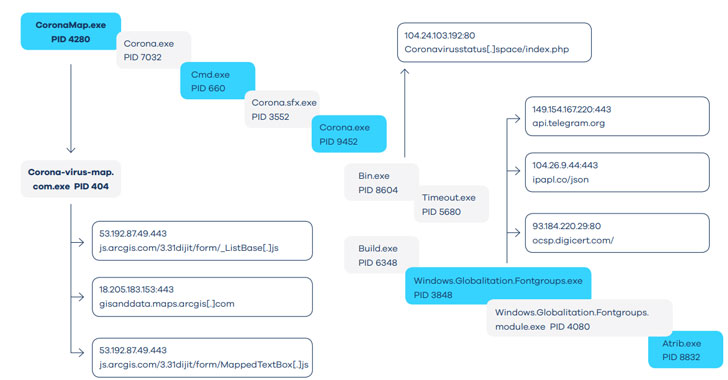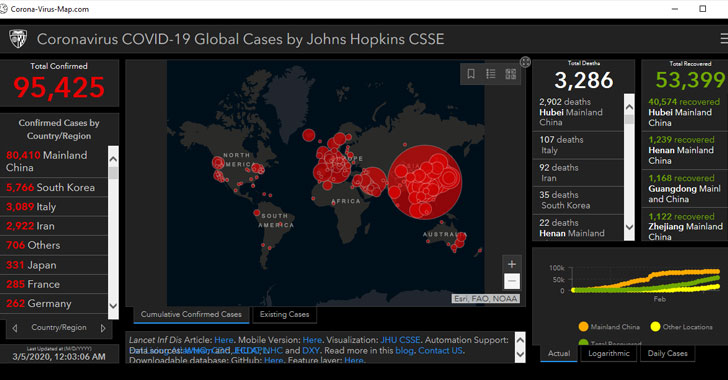There has always been a theme around malware creators take advantage of current topics. During tax season, we find fake tax services and tax scams. During American football season, we find fake fantasy football sources linked to exploit kits. Now with the Coronavirus, we are finding fake Coronavirus map malware. My advice is STOP INSTALLING CORONAVIRUS MAP SOFTWARE. If it’s a .exe, don’t install it. You can find the data you are looking for by viewing official websites from your country’s official web resource without installing anything. There is even a super popular website created by a 17th year that scrapes popular sources and spits out data and a map. That source is at https://ncov2019.live/map.
The hackernews wrote an article about the malware abusing the coronavirus situation. The original post can be found HERE. Here is that post.
Cybercriminals will stop at nothing to exploit every chance to prey on internet users.
Even the disastrous spread of SARS-COV-II (the virus), which causes COVID-19 (the disease), is becoming an opportunity for them to likewise spread malware or launch cyber attacks.
Reason Cybersecurity recently released a threat analysis report detailing a new attack that takes advantage of internet users’ increased craving for information about the novel coronavirus that is wreaking havoc worldwide.
The malware attack specifically aims to target those who are looking for cartographic presentations of the spread of COVID-19 on the Internet, and trickes them to download and run a malicious application that, on its front-end, shows a map loaded from a legit online source but in the background compromises the computer.
New Threat With An Old Malware Component
The latest threat, designed to steal information from unwitting victims, was first spotted by MalwareHunterTeam last week and has now been analyzed by Shai Alfasi, a cybersecurity researcher at Reason Labs.
It involves a malware identified as AZORult, an information-stealing malicious software discovered in 2016. AZORult malware collects information stored in web browsers, particularly cookies, browsing histories, user IDs, passwords, and even cryptocurrency keys.
With these data drawn from browsers, it is possible for cybercriminals to steal credit card numbers, login credentials, and various other sensitive information.
AZORult is reportedly discussed in Russian underground forums as a tool for gathering sensitive data from computers. It comes with a variant that is capable of generating a hidden administrator account in infected computers to enable connections via the remote desktop protocol (RDP).
Sample Analysis
Alfasi provides technical details upon studying the malware, which is embedded in the file, usually named as Corona-virus-Map.com.exe. It’s a small Win32 EXE file with a payload size of only around 3.26 MB.
Double-clicking the file opens a window that shows various information about the spread of COVID-19. The centerpiece is a “map of infections” similar to the one hosted by Johns Hopkins University, a legitimate online source to visualize and track reported coronavirus cases in the real-time.
Numbers of confirmed cases in different countries are presented on the left side while stats on deaths and recoveries are on the right. The window appears to be interactive, with tabs for various other related information and links to sources.
It presents a convincing GUI not many would suspect to be harmful. The information presented is not an amalgamation of random data, instead is actual COVID-19 information pooled from the Johns Hopkins website.
To be noted, the original coronavirus map hosted online by Johns Hopkins University or ArcGIS is not infect or backdoored in any way and are safe to visit.
The malicious software utilizes some layers of packing along with a multi-sub-process technique infused to make it challenging for researchers to detect and analyze. Additionally, it employs a task scheduler so it can continue operating.
Signs of Infection
Executing the Corona-virus-Map.com.exe results in the creation of duplicates of the Corona-virus-Map.com.exe file and multiple Corona.exe, Bin.exe, Build.exe, and Windows.Globalization.Fontgroups.exe files.

Additionally, the malware modifies a handful of registers under ZoneMap and LanguageList. Several mutexes are also created.
Execution of the malware activates the following processes: Bin.exe, Windows.Globalization.Fontgroups.exe, and Corona-virus-Map.com.exe. These attempt to connect to several URLs.
These processes and URLs are only a sample of what the attack entails. There are many other files generated and processes initiated. They create various network communication activities as malware tries to gather different kinds of information.
How the Attack Steals Information
Alfasi presented a detailed account of how he dissected the malware in a blog post on the Reason Security blog. One highlight detail is his analysis of the Bin.exe process with Ollydbg. Accordingly, the process wrote some dynamic link libraries (DLL). The DLL “nss3.dll” caught his attention as it is something he was acquainted with from different actors.

Alfasi observed a static loading of APIs associated with nss3.dll. These APIs appeared to facilitate the decryption of saved passwords as well as the generation of output data.
This is a common approach used by data thieves. Relatively simple, it only captures the login data from the infected web browser and moves it to the C:\Windows\Temp folder. It’s one of the hallmarks of an AZORult attack, wherein the malware extracts data, generates a unique ID of the infected computer, applies XOR encryption, then initiates C2 communication.
The malware makes specific calls in an attempt to steal login data from common online accounts such as Telegram and Steam.
To emphasize, malware execution is the only step needed for it to proceed with its information-stealing processes. Victims don’t need to interact with the window or input sensitive information therein.
Cleaning and Prevention
It may sound promotional, but Alfasi suggests Reason Antivirus software as the solution to fix infected devices and prevent further attacks. He is affiliated with Reason Security, after all. Reason is the first to find and scrutinize this new threat, so they can handle it effectively.
Other security firms are likely to have already learned about this threat, since Reason made it public on March 9. Their antiviruses or malware protection tools will have been updated as of publication time.
As such, they may be similarly capable of detecting and preventing the new threat.
The key to removing and stopping the opportunistic “coronavirus map” malware is to have the right malware protection system. It will be challenging to detect it manually, let alone remove the infection without the right software tool.
It may not be enough to be cautious in downloading and running files from the internet, as many tend to be overeager in accessing information about the novel coronavirus nowadays.
The pandemic level dispersion of COVID-19 merits utmost caution not only offline (to avoid contracting the disease) but also online. Cyber attackers are exploiting the popularity of coronavirus-related resources on the web, and many will likely fall prey to the attacks.
